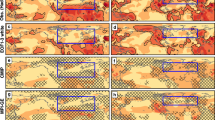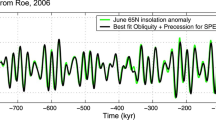Abstract
As climate changes due to the increase of greenhouse gases, there is the potential for climate variability to change as well. The change in variability of temperature and precipitation in a transient climate simulation, where trace gases are allowed to increase gradually, and in the doubled CO2 climate is investigated using the GISS general circulation model. The current climate control run is compared with observations and with the climate change simulations for variability on three time-scales: interannual variability, daily variability, and the amplitude of the diurnal cycle. The results show that the modeled variability is often larger than observed, especially in late summer, possibly due to the crude ground hydrology. In the warmer climates, temperature variability and the diurnal cycle amplitude usually decrease, in conjunction with a decrease in the latitudinal temperature gradient and the increased greenhouse inhibition of radiative cooling. Precipitation variability generally changes with the same sign as the mean precipitation itself, usually increasing in the warmer climate. Changes at a particular grid box are often not significant, with the prevailing tendency determined from a broader sampling. Little change is seen in daily persistence. The results are relevant to the continuing assessments of climate change impacts on society, though their use should be tempered by appreciation of the model deficiencies for the current climate.
Similar content being viewed by others
References
Angell, J. and Korshover, J.: 1978, ‘Global Temperature Variation, Surface - 100 mb: An Update into 1977’, Mon. Wea. Rev. 106, 355–370.
Barnett, T.: 1978, ‘Estimating Variability of Surface Air Temperature in the Northern Hemisphere’, Mon. Wea. Rev. 106, 1353–1367.
Chervin, R. M.: 1981, ‘On the Comparison of Observed and GCM Simulated Climate Ensembles’, J. Atmos. Sci. 38, 885–901.
Chin, E. H. and Miller, J. F.: 1980, ‘On the Conditional Distribution of Daily Precipitation Amounts’, Mon. Wea. Rev. 108, 1462–1464.
Diaz, H. and Quayle, R.: 1980, ‘The Climate of the United States Since 1985: Spatial and Temporal Changes’, Mon. Wea. Rev. 108, 249–266.
Emanuel, K. A.: 1987, ‘The Dependence of Hurricane Intensity on Climate’, Nature 326, 483–485.
Hansen, J. and Lebedeff, S.: 1987, ‘Global Trends of Measured Surface Air Temperature’, J. Geophys. Res. 92, 13,345–13,372.
Hansen, J., Russell, G., Rind, D., Stone, P., Lacis, A., Lebedeff, S., Ruedy, R., and Travis, L.: 1983, ‘Efficient Three-Dimensional Global Models for Climate Studies: Models I and II’, Mon. Wea. Rev. 111, 609–662.
Hansen, J., Lacis, A., Rind, D., Russell, G., Stone, P., Fung, I., Ruedy, R., and Lerner, J.: 1984, ‘Climate Sensitivity: Analysis of Feedback Mechanisms’, in J. Hansen and T. Takahashi (eds.), Climate Processes and Climate Sensitivity, American Geophysical Union, Washington, D.C., 130–163.
Hansen, J., Lacis, A., Rind, D., Russell, G., Fung, I., and Lebedeff, S.: 1987, ‘Evidence for Future Warming: How Large and When?’, in W. Shands and J. Hoffman (eds.), The Greenhouse Effect, Climate Change, and U.S. Forests, The Conservation Foundation, Washington, D.C., 57–76.
Hansen, J., Fung, I., Lacis, A., Lebedeff, S., Rind, D., Ruedy, R., Russell, G., and Stone, P.: 1988, ‘Global Climate Changes as Forecast by the Giss 3-d Model’, J. Geophys. Res. 93, 5385–5412.
Karl, T. R., Kukla, G., and Gavin, J.: 1984, ‘Decreasing Diurnal Temperature Range in the United States and Canada from 1941 through 1980’, J. Clim. App. Meteor. 23, 1489–1504.
Karl, T. R., Kukla, G., and Gavin, J.: 1986, ‘Relationship Between Decreased Temperature Range and Precipitation Trends in the United States and Canada, 1941–1980, J. Clim. App. Meteor. 25, 1878–1886.
Karl, T. R., Kukla, G., and Gavin, J.: 1987, ‘Recent Temperature Changes During Overcast and Clear Skies in the United States’, J. Clim. App. Meteor. 26, 698–711.
Katz, R. W.: 1984, Procedures for Determining the Statistical Significance of Changes in Variability Simulated by an Atmospheric General Circulation Model, Climate Research Institute Report No. 48, Oregon State University, Corvallis, Oregon.
Knuth, D. C.: 1969, The Art of Computer Programming, Addison-Wesley, Reading, Mass., 624 pp.
Panofsky, H. and Brier, G.: 1968, Some Applications of Statistics to Meteorology, The Pennsylvania State University, University Park, Pennsylvania, 224 pp.
Ratcliffe, R., Weller, J., and Collison, P.: 1978, ‘Variability in the Frequency of Unusual Weather over approximately the Last Century’, Quart. J. Roy. Meteor. Soc. 104, 243–256.
Rind, D.: 1987, ‘The Doubled CO2 Climate: Impact of the Sea Surface Temperature Gradient’, J. Atmos. Sci. 44, 3235–3268.
Rind, D.: 1988a, ‘The Doubled CO2 Climate and the Sensitivity of the Modeled Hydrologic Cycle’, J. Geophys. Res. 93, 5385–5412.
Rind, D.: 1988b, ‘Dependence of Warm and Cold Climate Depiction on Climate Model Resolution’, J. of Climate 1, 965–997.
Rind, D. and Lebedeff, S.: 1984, ‘Potential Climatic Impacts of Increasing Atmospheric CO2 with Emphasis on Water Availability and Hydrology in the United States’, Rep. EPA 230–04–84–006, U.S. Environ. Protection Agency, Washington, D.C., 96 pp.
Schlesinger, M. E. and Mitchell, J. F. B.: 1987, ‘Climate Model Simulations of the Equilibrium Climatic Response to Increased Carbon Dioxide’, Rev. Geophys. 25, 760–798.
Solomon, A. M. and West, D. C.: 1985, 'Potential Responses of Forests to CO2-Induced Climate Change, in M. R. White (ed.), Characterization of Information Requirements for Studies of CO 2 Effects: Water Resources, Agriculture, Fisheries, Forests and Human Health, United States Department of Energy, DOE/ER-0236, 145–170.
United States Air Force: 1979, ‘AWS Climatic Briefs — North America’, USAFETAC/DS-79/088, USAF Environmental Technical Applications Center, Scott Air Force Base, Illinois 62225.
United States Environmental Protection Agency: 1988, ‘Report to Congress on the Effects of Global Climate Change’, (in prep.).
van Loon, H. and Williams, J.: 1978, ‘The Association between Mean Temperatures and Interannual Variability’, Mon. Wea. Rev. 106, 1012–1017.
Wilson, C. A. and Mitchell, J. F. B.: 1987, ‘Simulated Climate and CO2-Induced Climate Change over Western Europe, Climatic Change 10, 11–42.
Author information
Authors and Affiliations
Rights and permissions
About this article
Cite this article
Rind, D., Goldberg, R. & Ruedy, R. Change in climate variability in the 21st century. Climatic Change 14, 5–37 (1989). https://doi.org/10.1007/BF00140173
Received:
Revised:
Issue Date:
DOI: https://doi.org/10.1007/BF00140173




